Uncertainty Evaluation Method of Marine Soil Wave Velocity Prediction Model Based on Point Estimation Method and Bayesian Principle
Abstract
1. Introduction
2. Uncertainty Analysis Based on the Point Estimation Method
2.1. Fundamental Principles of the Point Estimation Method
2.2. Uncertainty Propagation in the Power Function Prediction Model
3. Bayesian Inference for Power Function Fitting Parameters a and b
3.1. Prior Information
3.2. Posterior Information
4. Uncertainty Analysis of Predicted Vs Values for Soils in a Certain Bay in China
4.1. Site Overview
4.2. Uncertainty Analysis of Predicted Vs Values for Soils in the Study Area Based on Bayesian Theory and Point Estimation Method
4.3. Comparison with Monte Carlo Simulation Results
4.4. Impact of Vs Uncertainty On-Site Seismic Response Results
- Input Ground Motion: Select a real recorded or artificially synthesized ground motion acceleration time-history as input.
- Model Establishment: Establish a set of single-degree-of-freedom (SDOF) system models with a fixed damping ratio and different natural vibration periods.
- Dynamic Time-History Analysis: Apply the input ground motion to each SDOF model separately and compute the entire vibration process (displacement, velocity, acceleration) under seismic action through numerical integration.
- Peak Value Extraction: From the full time-history response of each model, identify the absolute maximum value of its response (such as maximum absolute acceleration, maximum relative velocity, or maximum relative displacement).
- Plotting the Spectrum: Use the natural vibration period of each SDOF model as the horizontal coordinate and the corresponding calculated maximum response value as the vertical coordinate. The curve formed by connecting all these points is the (acceleration, velocity, or displacement) response spectrum corresponding to that ground motion.
5. Conclusions
- (1)
- A power function regression equation was established to relate Vs and h. Prior distributions for the mean and variance of parameters a and b in the power function were derived from six sets of historical data. The prior means of a and b conform to a normal distribution, while their prior variances conform to an inverse gamma distribution.
- (2)
- The posterior distributions of the mean and variance for a and b were obtained by combining their prior distributions with on-site sample data. Using the maximum posterior mean of a and b with the point estimation method, the variation in the mean and standard deviation of predicted Vs values with h (when using the power function) was derived. The accuracy of the point estimation method results was validated via Monte Carlo simulation.
- (3)
- Compared to Vs predictions based solely on the mean of a and b from on-site samples, Vs predictions derived from the maximum posterior mean of a and b align more closely with measured Vs values. Consequently, the corresponding site seismic response analysis results also more closely match those calculated using true Vs values.
Author Contributions
Funding
Data Availability Statement
Conflicts of Interest
Abbreviations
| Vs | Shear wave velocity of soil |
| h | Depth of soil cover |
| x+ | Upper bound of the variation range for random variable x in a univariate function |
| x− | Lower bound of the variation range for random variable x in a univariate function |
| y+ | Value of function y when random variable x approaches x from the right (x → x+) in a univariate function |
| y− | Value of function y when random variable x approaches x from the left (x → x−) in a univariate function |
| Mean of random variable x | |
| σ[x] | Standard deviation of random variable x |
| xi+ | Upper bound of the variation range for the i-th random variable x in a bivariate function |
| xi− | Lower bound of the variation range for the i-th random variable x in a bivariate function |
| Mean of the i-th random variable x in a bivariate function | |
| σ[xi] | Standard deviation of the i-th random variable x in a bivariate function |
| y±± | Variation range of function y caused by the change in random variable xi in a bivariate function |
| E[y] | Mean of function y |
| E[y2] | Second-order moment of function y |
| P±± | Weight coefficient for the value of y±± |
| Correlation coefficient between random variables x1 and x2 | |
| Cov(x1, x2) | Covariance of random variables x1 and x2 |
| V[x1] | Variance of random variable x1 |
| V[x2] | Variance of random variable x2 |
| σ[y] | Standard deviation of function y |
| Vs(h) | Soil shear wave velocity at depth h |
| Mean of power function fitting parameter a | |
| Mean of power function fitting parameter b | |
| σ[a] | Standard deviation of power function fitting parameter a |
| σ[b] | Standard deviation of power function fitting parameter b |
| E[Vs(h)] | Mean soil shear wave velocity at depth h |
| Correlation coefficient between power function fitting parameters a and b | |
| COV(a, b) | Covariance of power function fitting parameters a and b |
| V[a] | Variance of power function fitting parameter a |
| V[b] | Variance of power function fitting parameter b |
| Vs ± ± | Variation bounds of soil shear wave velocity |
| σ[Vs (h)] | Standard deviation of soil shear wave velocity at different depths h |
| Second-order moment of soil shear wave velocity at different depths | |
| π (μ, σ2) | Joint prior distribution of mean μ and variance σ2, which is the Normal–Inverse Gamma distribution |
| π (σ2) | Prior probability density function of variance σ2 |
| π (μ|σ2) | Prior probability density function of the random variable’s mean μ, given its variance σ2 |
| N (μ0, σ2/κ0) | Prior normal distribution for the random variable’s mean μ, with mean μ0; and variance σ2/κ0 |
| Prior inverse gamma distribution for the random variable’s variance, with mean and variance | |
| m | Number of groups obtained from grouping prior samples |
| μ0, κ0 and σ0 | Hyperparameters to be determined in the prior distribution |
| Estimate of μ0 | |
| Mean of the i-th group of prior samples | |
| Estimated value of σ2 | |
| Variance of the ith group of prior samples | |
| Estimated value of κ0 | |
| Mean variance of the prior sample data | |
| Variance of the prior sample data | |
| Joint posterior distribution of the mean μ and variance σ2 of the random variable x | |
| p(x| μ, σ) | Probability density function of the random variable x with parameters μ and σ |
| m (x) | Marginal distribution of the random variable x |
| μn, νn, κn and σn | Parameters in the posterior distribution |
| n | Number of field samples |
| Mean of the field samples | |
| s2 | Variance of the field samples |
| μMD | Maximum a posteriori mean |
| Maximum a posteriori variance | |
| N | Number of Monte Carlo simulations |
| Standard deviation of Vs obtained from N Monte Carlo simulations at an arbitrary depth hα | |
| Simulated value of Vs at an arbitrary depth hα in the lth (l = 1, 2, …, N) Monte Carlo simulation | |
| EAσ | Mean after N simulations of |
| COV[EAσ] | Coefficient of variation of EAσ |
| g | Gravitational acceleration |
| Sa | Response spectrum value |
References
- Gong, W.; Juang, C.H.; Martin, J.R.; Tang, H.; Wang, Q.; Huang, H. Probabilistic analysis of tunnel longitudinal performance based upon conditional random field simulation of soil properties. Tunn. Undergr. Space Technol. 2018, 73, 1–14. [Google Scholar] [CrossRef]
- Cami, B.; Javankhoshdel, S.; Phoon, K.-K.; Ching, J. Scale of Fluctuation for Spatially Varying Soils: Estimation Methods and Values. ASCE-ASME J. Risk Uncertain. Eng. Syst. A Civ. Eng. 2020, 6, 03120002. [Google Scholar] [CrossRef]
- Jiang, S.-H.; Huang, J.; Griffiths, D.V.; Deng, Z.-P. Advances in reliability and risk analyses of slopes in spatially variable soils: A state-of-the-art review. Comput. Geotech. 2022, 141, 104498. [Google Scholar] [CrossRef]
- Phoon, K.-K.; Cao, Z.-J.; Ji, J.; Leung, Y.F.; Najjar, S.; Shuku, T.; Tang, C.; Yin, Z.-Y.; Ikumasa, Y.; Ching, J. Geotechnical uncertainty, modeling, and decision making. Soils Found. 2022, 62, 101189. [Google Scholar] [CrossRef]
- Zhang, Z.; Xu, G.; Pan, F.; Zhang, Y.; Huang, J.; Zhou, Z. Simulation Method and Application of Non-Stationary Random Fields for Deeply Dependent Seabed Soil Parameters. J. Mar. Sci. Eng. 2024, 12, 2183. [Google Scholar] [CrossRef]
- Zefa, L.; Zhenyu, W.; Xiang, L.; Liang, P.; Zhe, Y. Influence of Spatial Variability of Tensile Strength on Seismic Cracking of Gravity Dam. Adv. Eng. Sci. 2019, 51, 116–124. [Google Scholar] [CrossRef]
- Garini, E.; Anastasopoulos, I.; Gazetas, G.; O’Riordan, N.; Kumar, P.; Ellison, K.; Ciruela-Ochoa, F. Soil, basin and soil–building–soil interaction effects on motions of Mexico City during seven earthquakes. Géotechnique 2022, 72, 556–564. [Google Scholar] [CrossRef]
- Sun, Q.; Guo, X.; Dias, D. Evaluation of the seismic site response in randomized velocity profiles using a statistical model with Monte Carlo simulations. Comput. Geotech. 2020, 120, 103442. [Google Scholar] [CrossRef]
- Tran, T.-T.; Salman, K.; Han, S.-R.; Kim, D. Probabilistic Models for Uncertainty Quantification of Soil Properties on Site Response Analysis. ASCE-ASME J. Risk Uncertain. Eng. Syst. A Civ. Eng. 2020, 6, 04020030. [Google Scholar] [CrossRef]
- Huang, D.; Wang, G.; Du, C.; Jin, F. Seismic Amplification of Soil Ground with Spatially Varying Shear Wave Velocity Using 2D Spectral Element Method. J. Earthq. Eng. 2021, 25, 2834–2849. [Google Scholar] [CrossRef]
- Liu, W.; Juang, C.H.; Chen, Q.; Chen, G. Dynamic site response analysis in the face of uncertainty–an approach based on response surface method. Int. J. Numer. Anal. Methods Geomech. 2021, 45, 1854–1867. [Google Scholar] [CrossRef]
- Kim, G.Y.; Yoon, H.J.; Kim, J.W.; Kim, D.C.; Khim, B.K.; Kim, S.Y. The Effects of Microstructure on Shear Properties of Shallow Marine Sediments. Mar. Georesources Geotechnol. 2007, 25, 37–51. [Google Scholar] [CrossRef]
- Kulkarni, M.P.; Patel, A.; Singh, D.N. Application of shear wave velocity for characterizing clays from coastal regions. KSCE J. Civ. Eng. 2010, 14, 307–321. [Google Scholar] [CrossRef]
- Wang, S.-Y.; Wang, H.-Y. Site-dependent shear-wave velocity equations versus depth in California and Japan. Soil Dyn. Earthq. Eng. 2016, 88, 8–14. [Google Scholar] [CrossRef]
- L’Heureux, J.-S.; Long, M. Relationship between Shear-Wave Velocity and Geotechnical Parameters for Norwegian Clays. J. Geotech. Geoenviron. Eng. 2017, 143, 04017013. [Google Scholar] [CrossRef]
- Miah, M.I. Improved prediction of shear wave velocity for clastic sedimentary rocks using hybrid model with core data. J. Rock Mech. Geotech. Eng. 2021, 13, 1466–1477. [Google Scholar] [CrossRef]
- Hu, Q.; Li, H.; Yang, G.; Cai, Y. Effects of Uncertainty of Dynamic Shear Modulus Ratio on Design Ground Motion. Soil Mech. Found. Eng. 2019, 56, 82–90. [Google Scholar] [CrossRef]
- Hamilton, E.L. Shear-Wave Velocity Versus Depth In Marine Sediments: A Review. Geophysics 1976, 41, 985–996. [Google Scholar] [CrossRef]
- Moon, S.-W.; Ku, T. Development of global correlation models between in situ stress-normalized shear wave velocity and soil unit weight for plastic soils. Can. Geotech. J. 2016, 53, 1600–1611. [Google Scholar] [CrossRef]
- Moon, S.-W.; Ng, Y.C.H.; Ku, T. Global semi-empirical relationships for correlating soil unit weight with shear wave velocity by void-ratio function. Can. Geotech. J. 2018, 55, 1193–1199. [Google Scholar] [CrossRef]
- Yan, Z.; Kai, Z.; Yanjv, P.; Guoxing, C. Dynamic shear modulus and damping ratio characteristics of undisturbed marine soils in the Bohai Sea, China. Earthq. Eng. Eng. Vib. 2022, 21, 297–312. [Google Scholar] [CrossRef]
- Wu, Q.; Wang, Z.; Qin, Y.; Yang, W. Intelligent Model for Dynamic Shear Modulus and Damping Ratio of Undisturbed Marine Clay Based on Back-Propagation Neural Network. J. Mar. Sci. Eng. 2023, 11, 249. [Google Scholar] [CrossRef]
- Wang, Y.; Au, S.-K.; Cao, Z. Bayesian approach for probabilistic characterization of sand friction angles. Eng. Geol. 2010, 114, 354–363. [Google Scholar] [CrossRef]
- Cao, Z.; Wang, Y. Bayesian model comparison and selection of spatial correlation functions for soil parameters. Struct. Saf. 2014, 49, 10–17. [Google Scholar] [CrossRef]
- Ching, J.; Wu, S.-S.; Phoon, K.-K. Statistical characterization of random field parameters using frequentist and Bayesian approaches. Can. Geotech. J. 2016, 53, 285–298. [Google Scholar] [CrossRef]
- Goharzay, M.; Noorzad, A.; Ardakani, A.M.; Jalal, M. A worldwide SPT-based soil liquefaction triggering analysis utilizing gene expression programming and Bayesian probabilistic method. J. Rock Mech. Geotech. Eng. 2017, 9, 683–693. [Google Scholar] [CrossRef]
- Contreras, L.F.; Brown, E.T.; Ruest, M. Bayesian data analysis to quantify the uncertainty of intact rock strength. J. Rock Mech. Geotech. Eng. 2018, 10, 11–31. [Google Scholar] [CrossRef]
- Sun, Z.; Gao, P.; Gao, Y.; Bi, J.; Gao, Q. Probabilistic Prediction of Spudcan Bearing Capacity in Stiff-over-Soft Clay Based on Bayes’ Theorem. J. Mar. Sci. Eng. 2025, 13, 1344. [Google Scholar] [CrossRef]
- Rosenblueth, E. Two-point estimates in probabilities. Appl. Math. Model. 1981, 5, 329–335. [Google Scholar] [CrossRef]
- HARR, M.E. Reliability-Based Design in Civil Engineering; McGraw-Hill Book Company: New York, NY, USA, 1987. [Google Scholar]
- Zhang, J.; Andrus, R.D.; Juang, C.H. Model Uncertainty in Normalized Shear Modulus and Damping Relationships. J. Geotech. Geoenviron. Eng. 2008, 134, 24–36. [Google Scholar] [CrossRef]
- Park, D.; Kim, H.-M.; Ryu, D.-W.; Song, W.-K.; Sunwoo, C. Application of a point estimate method to the probabilistic limit-state design of underground structures. Int. J. Rock Mech. Min. Sci. 2012, 51, 97–104. [Google Scholar] [CrossRef]
- Zhang, Y.; Zhang, Z.; Xu, G.; Ren, Y.; Bai, X.; Qin, Y.; Zhao, K.; Chen, G.; Zhou, Z.; Jiang, J. Improved conditional random field simulation method based on bootstrap-Bayesian inference and its application in identification of seafloor liquefaction. Probabilistic Eng. Mech. 2025, 82, 103847. [Google Scholar] [CrossRef]
- Abid, S.H.; Al-Hassany, S.A. On the Inverted Gamma Distribution. Int. J. Syst. Sci. Appl. Math. 2016, 1, 1–8. [Google Scholar]
- Llera, A.; Beckmann, C.F. Estimating an Inverse Gamma distribution. arXiv 2016, arXiv:1605.01019. [Google Scholar] [CrossRef]
- Tronarp, F.; Särkkä, S.; Hennig, P. Bayesian ODE solvers: The maximum a posteriori estimate. Stat. Comput. 2021, 31, 23. [Google Scholar] [CrossRef]
- Gong, W.; Zhao, C.; Juang, C.H.; Zhang, Y.; Tang, H.; Lu, Y. Coupled characterization of stratigraphic and geo-properties uncertainties–A conditional random field approach. Eng. Geol. 2021, 294, 106348. [Google Scholar] [CrossRef]
- Chen, G.; Wang, Y.; Zhao, D.; Zhao, K.; Yang, J. A new effective stress method for nonlinear site response analyses. Earthq. Eng. Struct. Dyn. 2021, 50, 1595–1611. [Google Scholar] [CrossRef]
- Lv, Y.; Tang, R.; Peng, Y.; Xv, G. Engineering Earthquake Research in Bohai Oilfield; Seismological Press: Beijing, China, 2003. (In Chinese) [Google Scholar]
- Anil, K.; Chopra. Application of Structural Dynamics Theory in Earthquake Engineering; Higher Education Press: Beijing, China, 2016. (In Chinese) [Google Scholar]
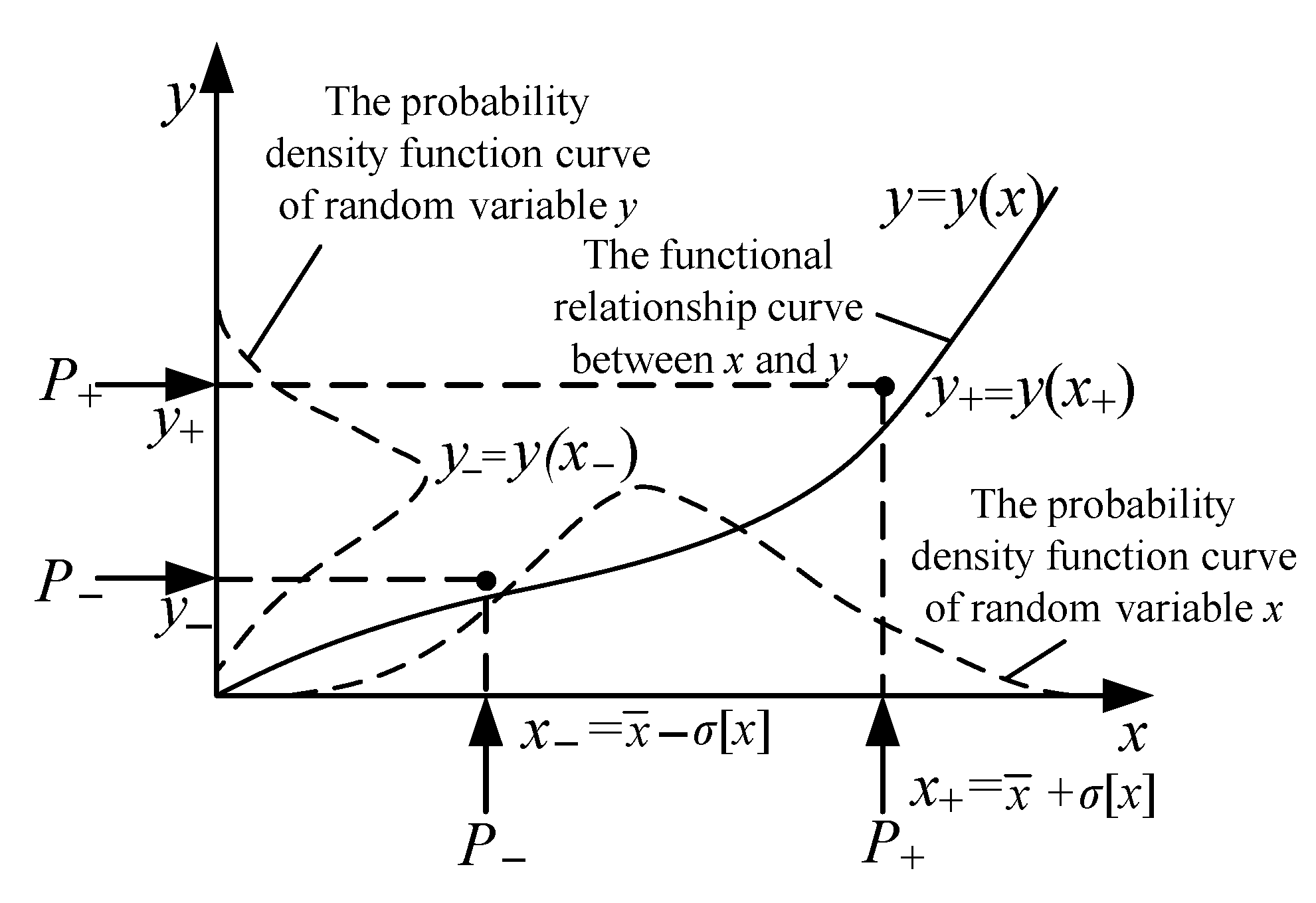
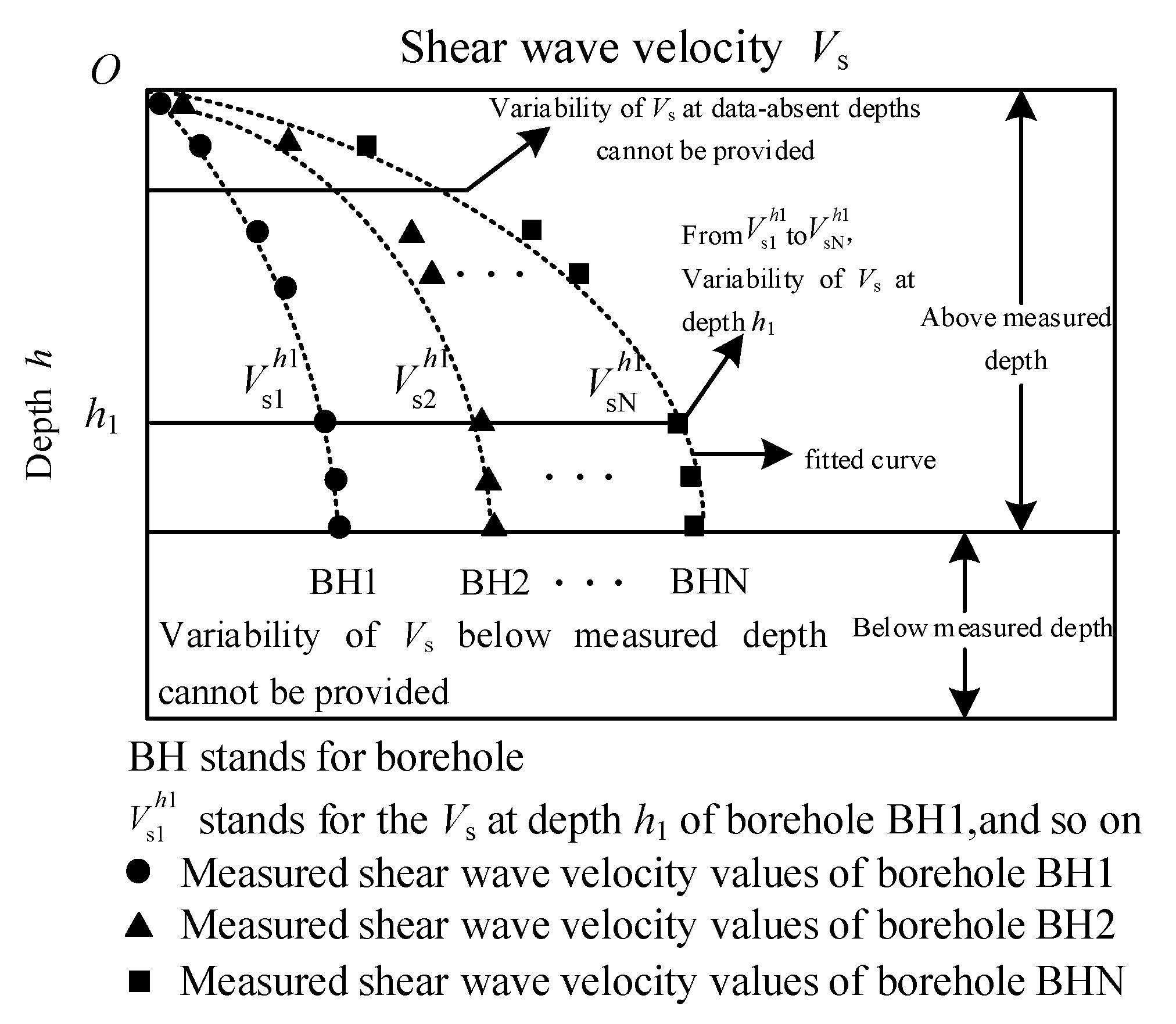


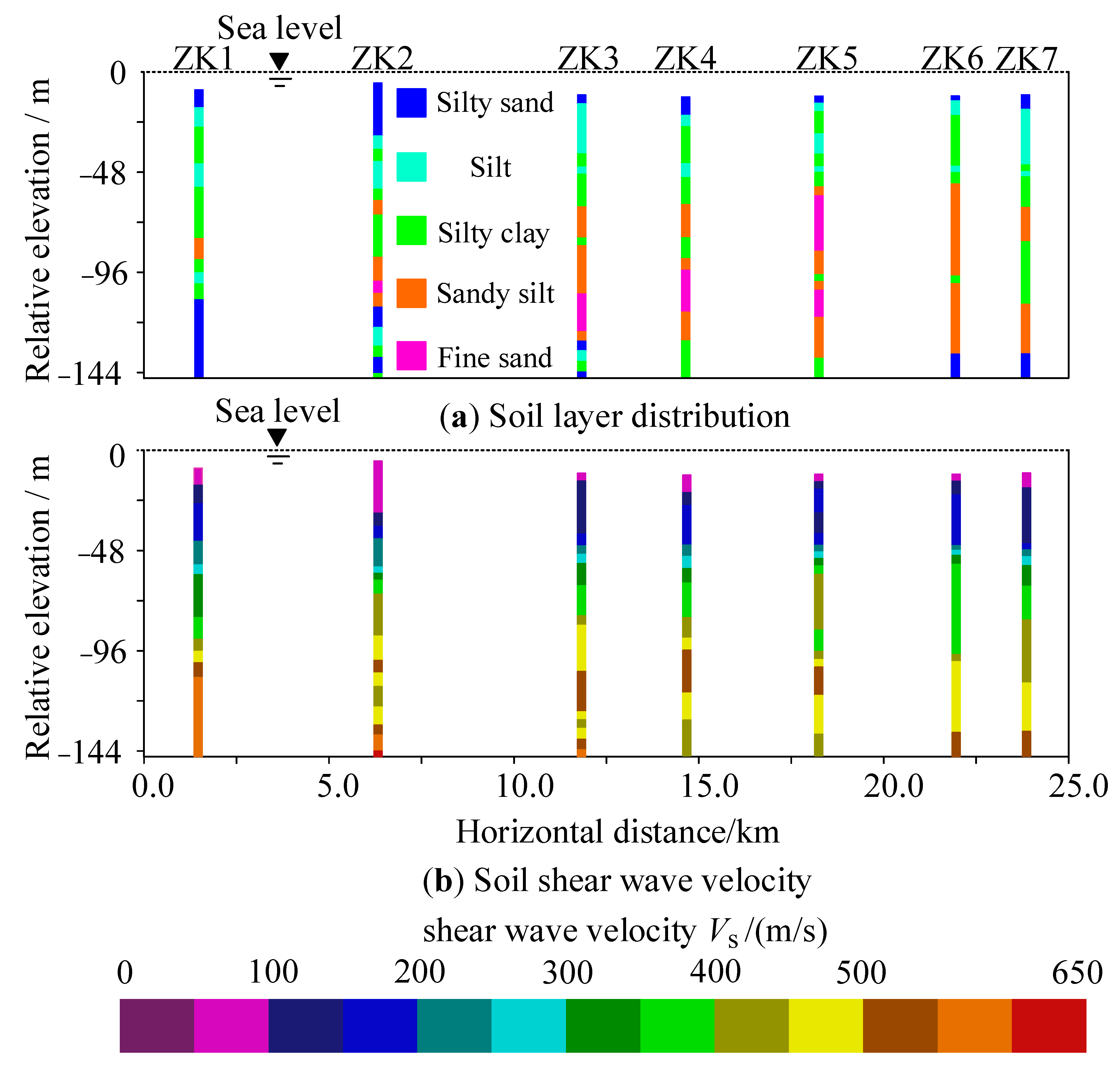
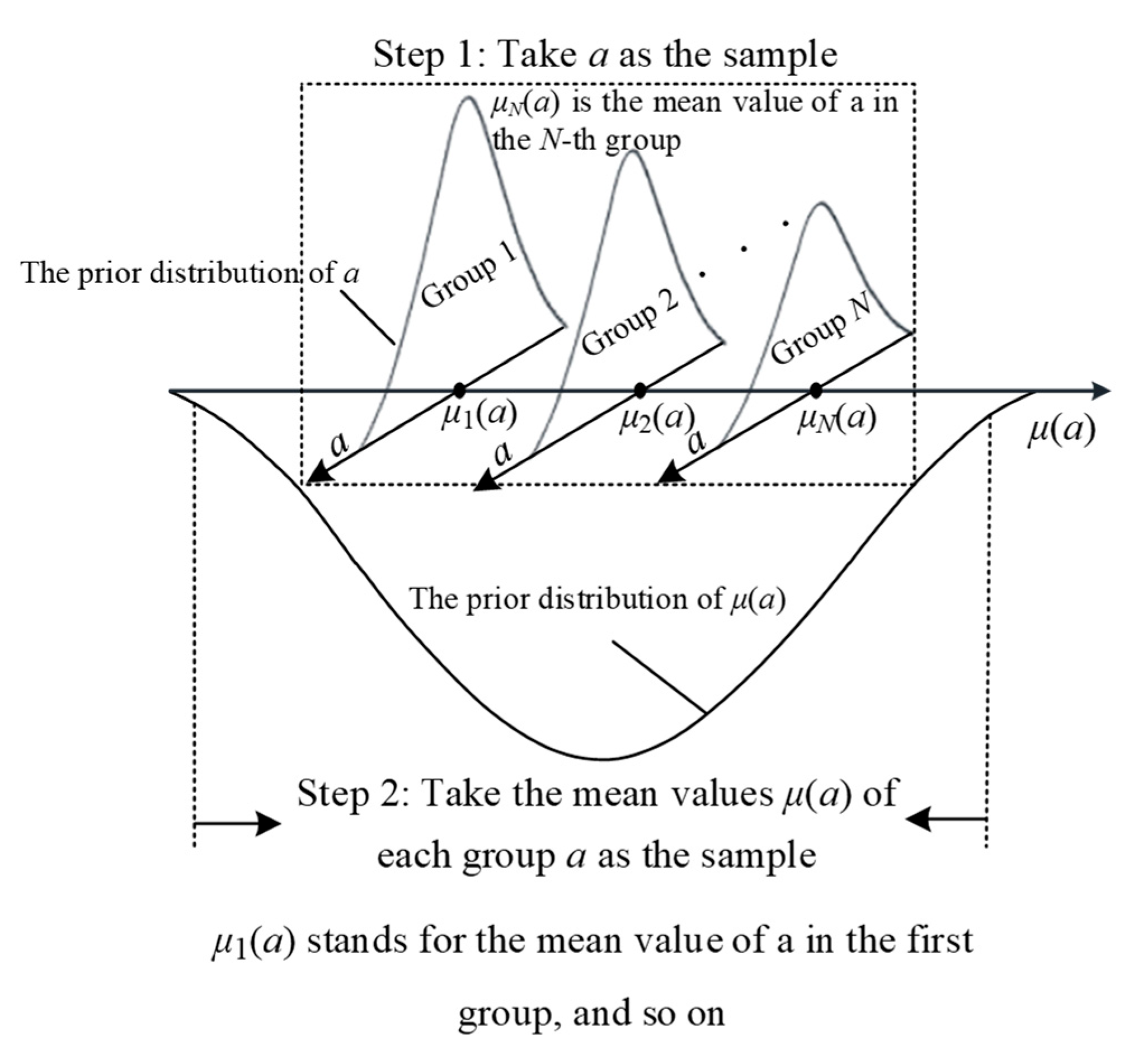
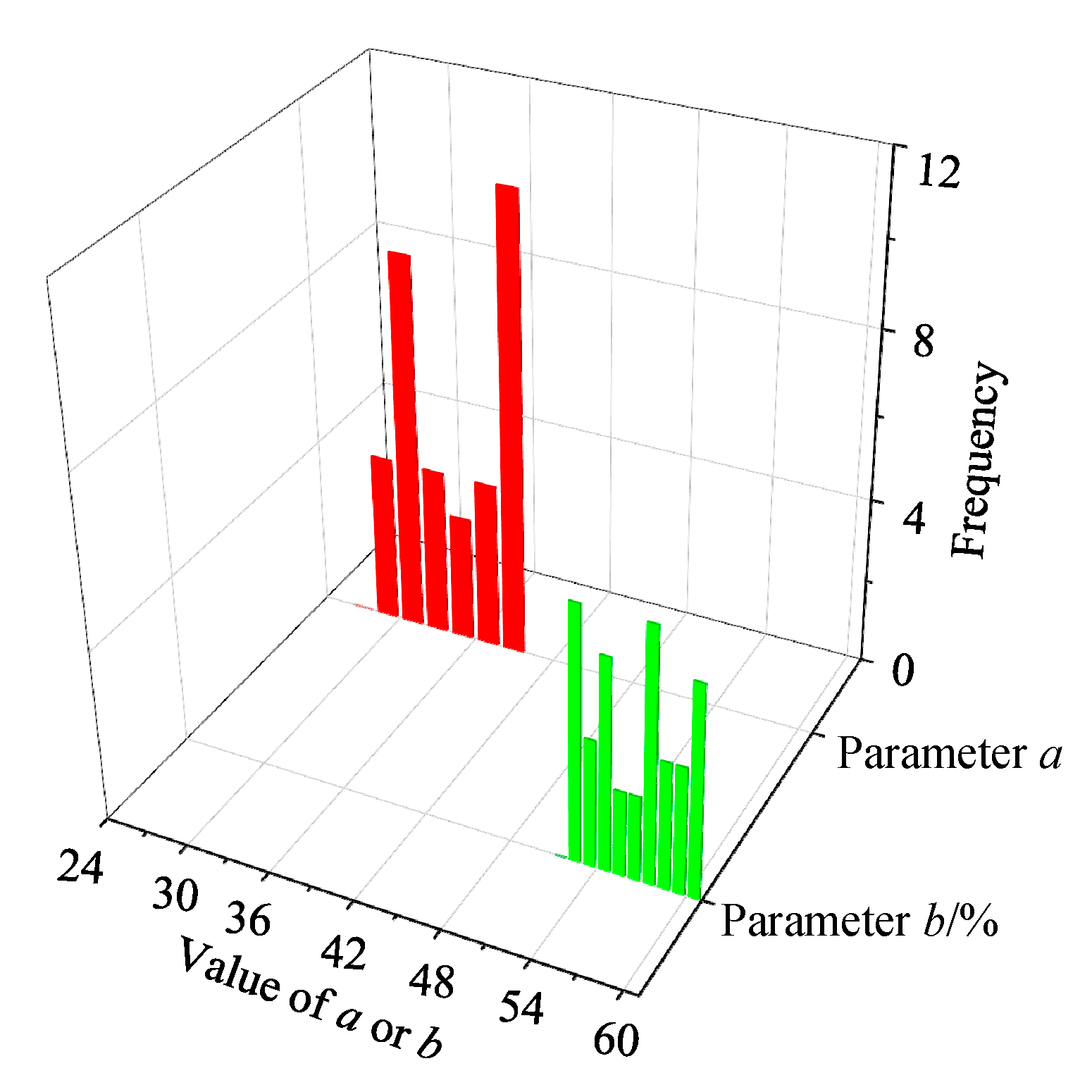

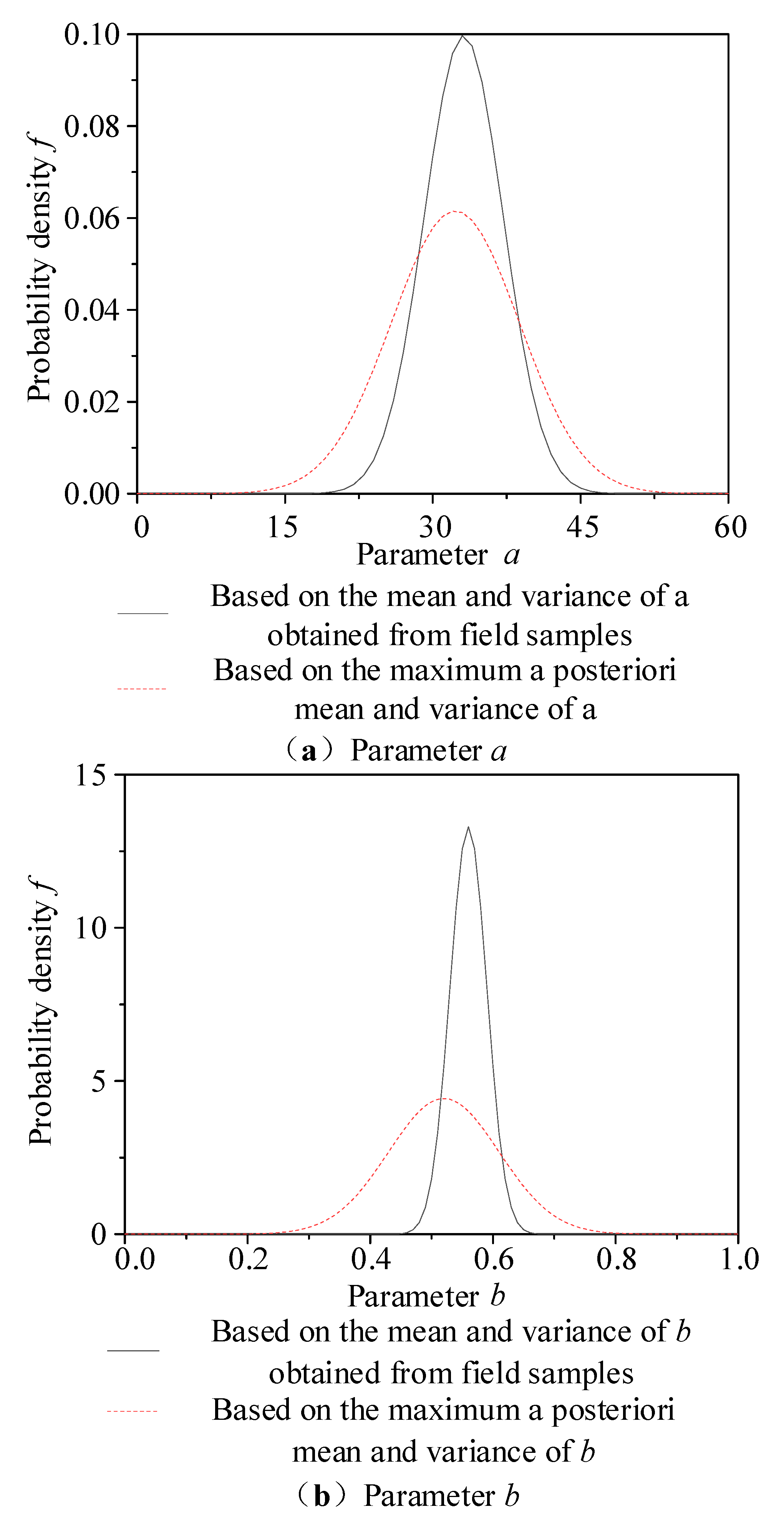
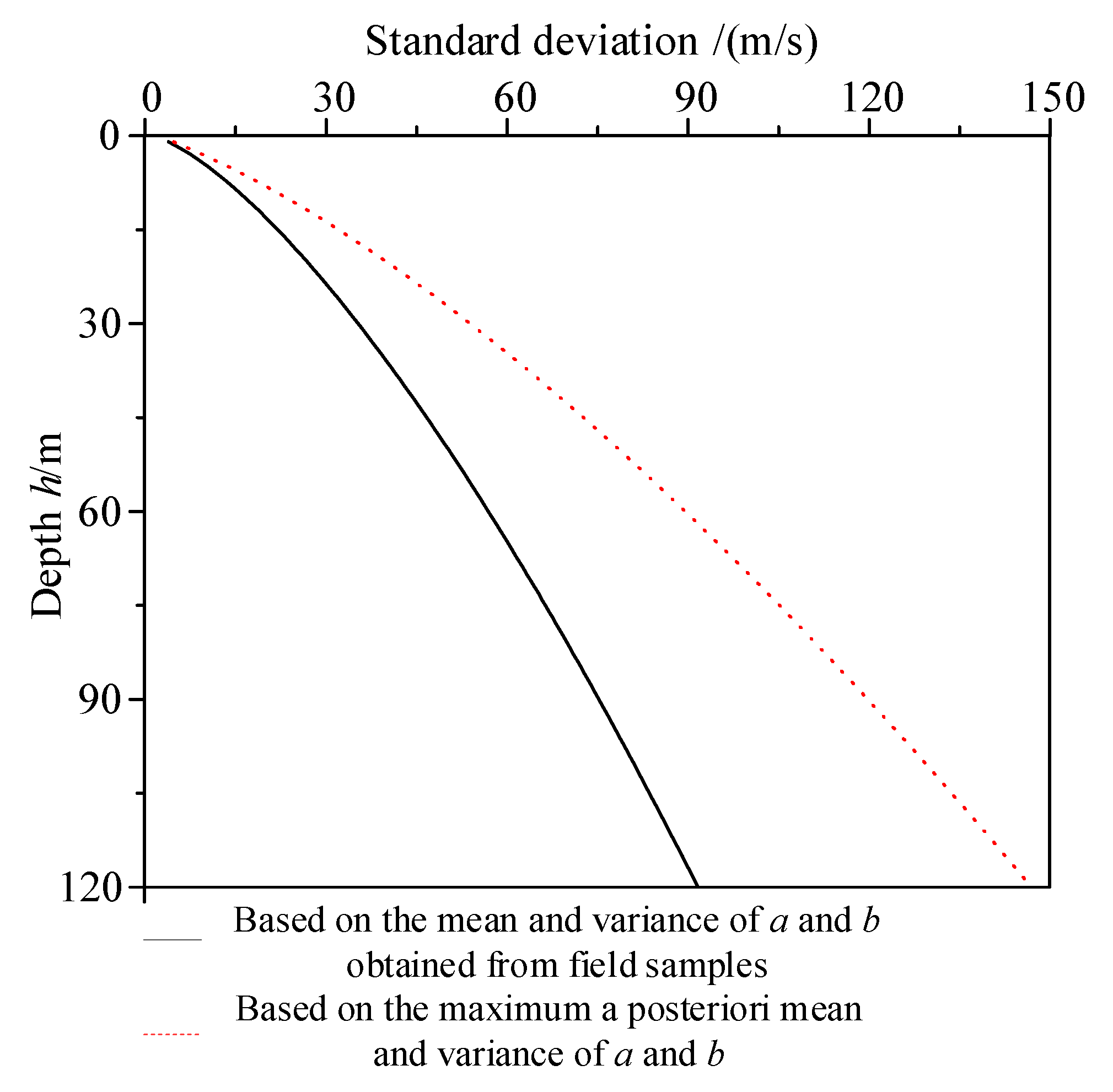
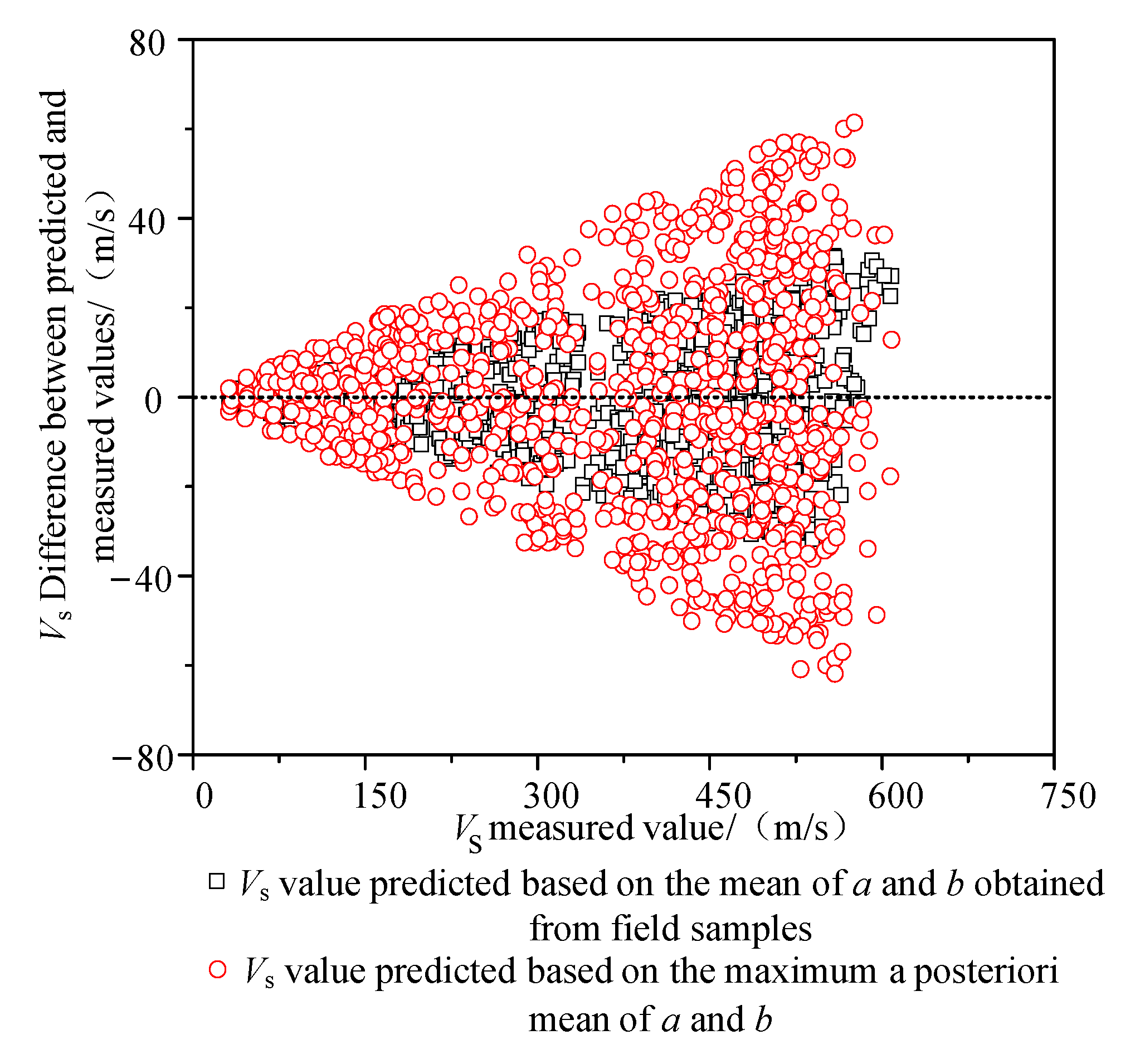
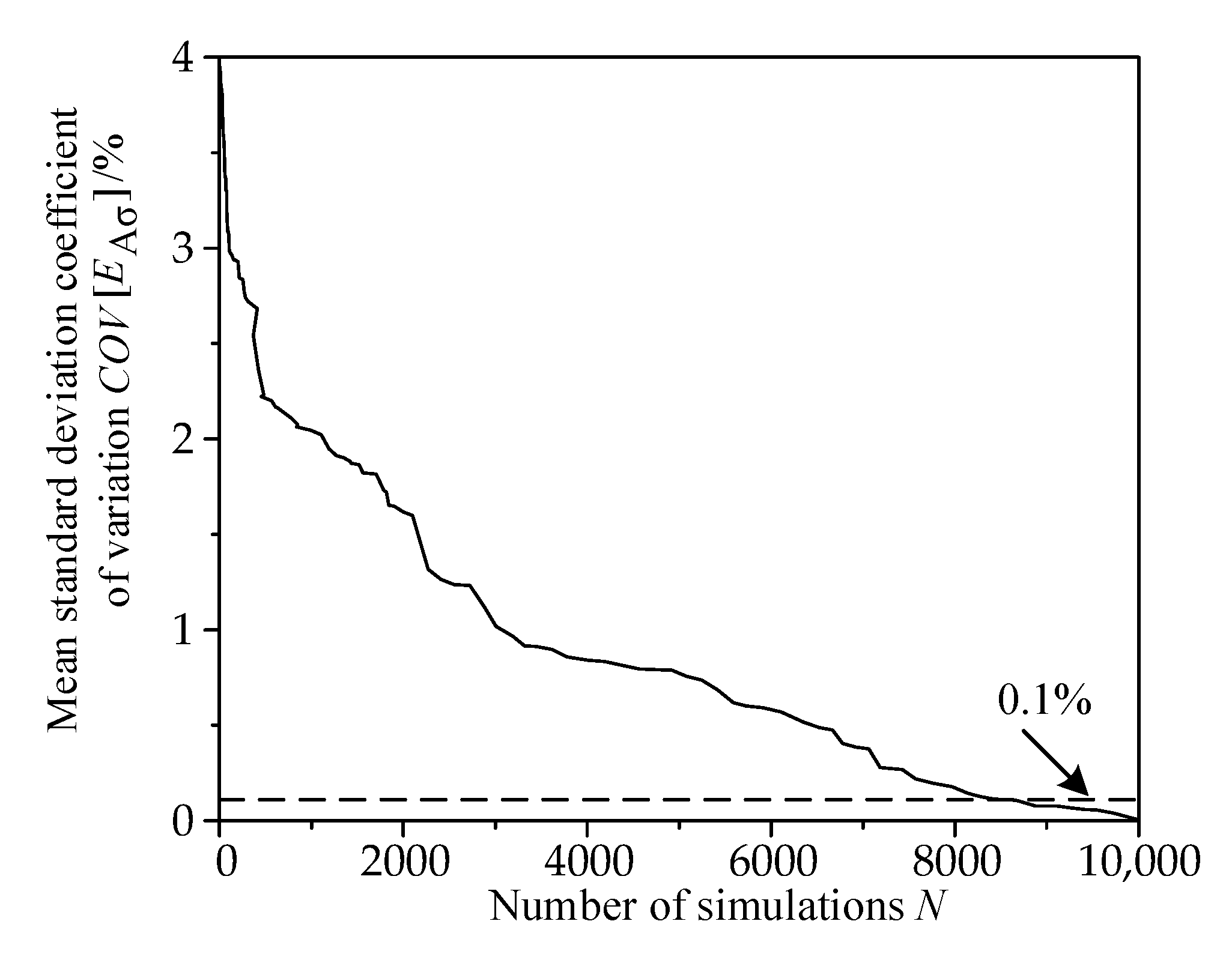
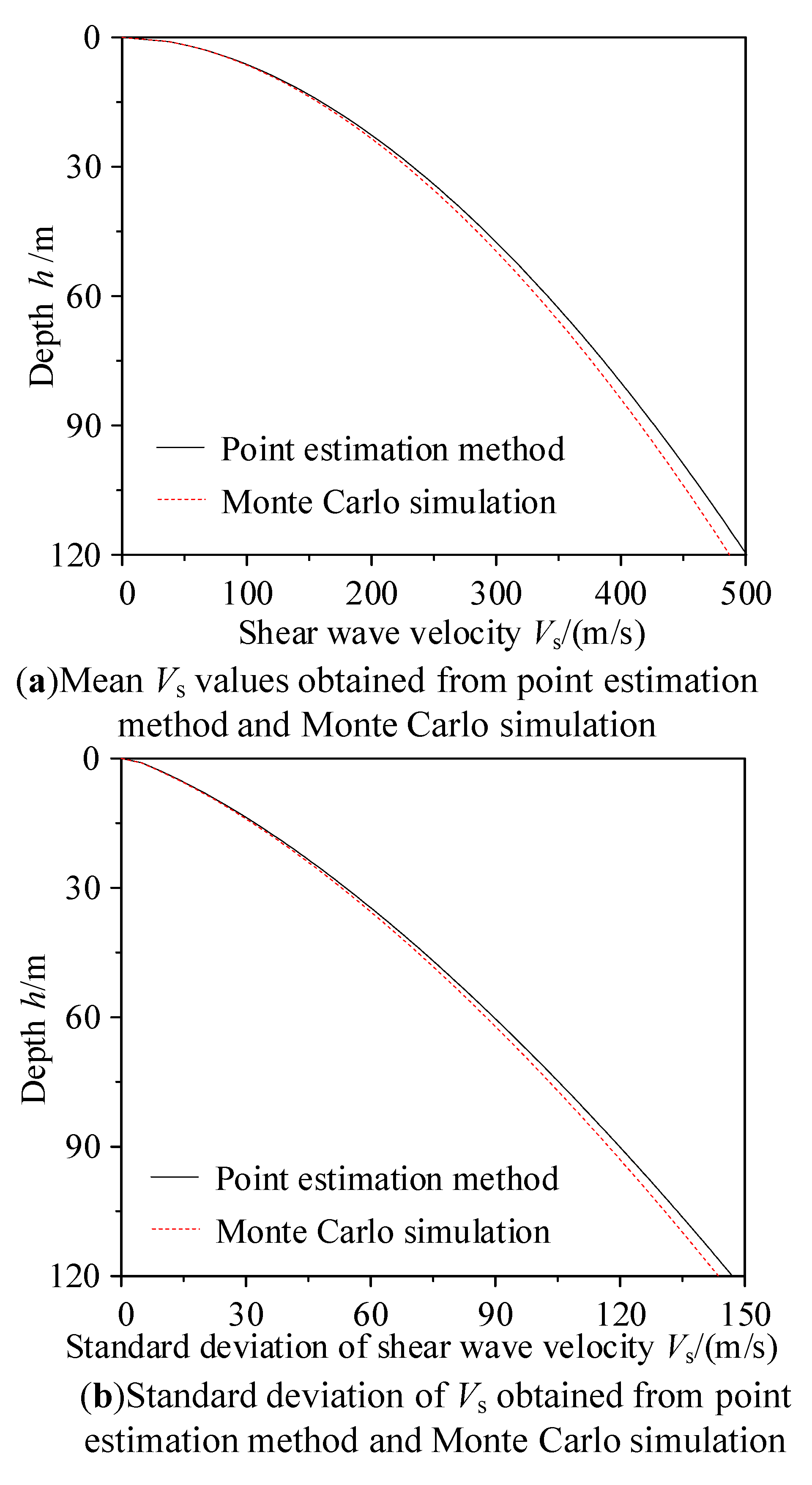
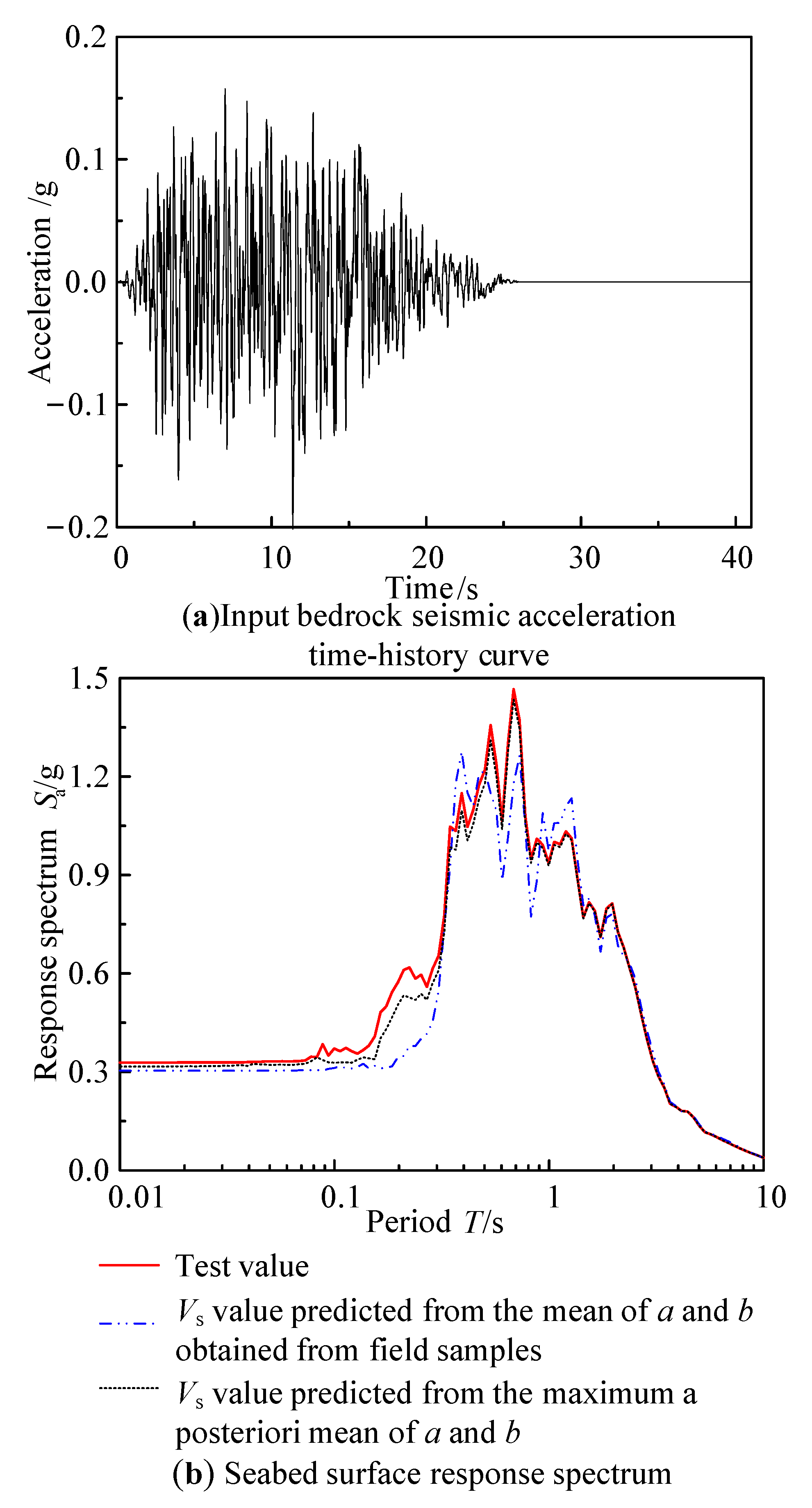
| Category | Soil Type | Parameter a | Parameter b | ||
|---|---|---|---|---|---|
| Mean | Standard Deviation | Mean | Standard Deviation | ||
| On-site | Silty Sand | 25.13 | 3.48 | 0.65 | 0.06 |
| On-site | Silt | 23.02 | 4.24 | 0.58 | 0.05 |
| On-site | Silty Clay | 33.14 | 4.00 | 0.56 | 0.03 |
| On-site | Sandy Silt | 73.35 | 7.78 | 0.40 | 0.04 |
| On-site | Fine Sand | 111.59 | 12.47 | 0.33 | 0.02 |
| Maximum Posterior | Silty Sand | 24.53 | 6.38 | 0.58 | 0.11 |
| Maximum Posterior | Silt | 22.09 | 7.53 | 0.50 | 0.13 |
| Maximum Posterior | Silty Clay | 32.29 | 6.48 | 0.52 | 0.09 |
| Maximum Posterior | Sandy Silt | 72.88 | 11.87 | 0.36 | 0.08 |
| Maximum Posterior | Fine Sand | 110.06 | 19.12 | 0.30 | 0.06 |
Disclaimer/Publisher’s Note: The statements, opinions and data contained in all publications are solely those of the individual author(s) and contributor(s) and not of MDPI and/or the editor(s). MDPI and/or the editor(s) disclaim responsibility for any injury to people or property resulting from any ideas, methods, instructions or products referred to in the content. |
© 2025 by the authors. Licensee MDPI, Basel, Switzerland. This article is an open access article distributed under the terms and conditions of the Creative Commons Attribution (CC BY) license (https://creativecommons.org/licenses/by/4.0/).
Share and Cite
Xu, G.; Zhang, Z.; Chen, R.; Pan, F.; Zhang, Y. Uncertainty Evaluation Method of Marine Soil Wave Velocity Prediction Model Based on Point Estimation Method and Bayesian Principle. J. Mar. Sci. Eng. 2025, 13, 1939. https://doi.org/10.3390/jmse13101939
Xu G, Zhang Z, Chen R, Pan F, Zhang Y. Uncertainty Evaluation Method of Marine Soil Wave Velocity Prediction Model Based on Point Estimation Method and Bayesian Principle. Journal of Marine Science and Engineering. 2025; 13(10):1939. https://doi.org/10.3390/jmse13101939
Chicago/Turabian StyleXu, Guanlan, Zhengyang Zhang, Rundi Chen, Fengqian Pan, and Yan Zhang. 2025. "Uncertainty Evaluation Method of Marine Soil Wave Velocity Prediction Model Based on Point Estimation Method and Bayesian Principle" Journal of Marine Science and Engineering 13, no. 10: 1939. https://doi.org/10.3390/jmse13101939
APA StyleXu, G., Zhang, Z., Chen, R., Pan, F., & Zhang, Y. (2025). Uncertainty Evaluation Method of Marine Soil Wave Velocity Prediction Model Based on Point Estimation Method and Bayesian Principle. Journal of Marine Science and Engineering, 13(10), 1939. https://doi.org/10.3390/jmse13101939






